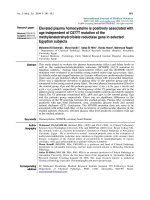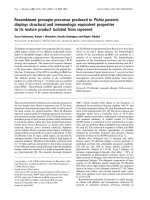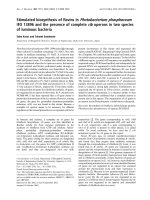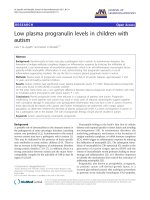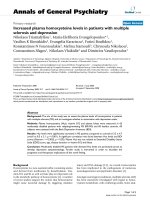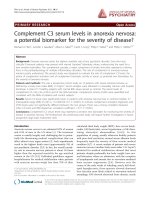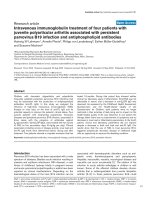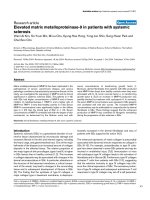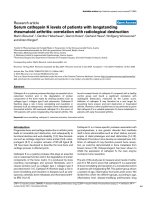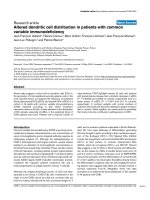Báo cáo y học: "Increased plasma homocysteine levels in patients with multiple sclerosis and depression" ppsx
Bạn đang xem bản rút gọn của tài liệu. Xem và tải ngay bản đầy đủ của tài liệu tại đây (381.03 KB, 5 trang )
BioMed Central
Page 1 of 5
(page number not for citation purposes)
Annals of General Psychiatry
Open Access
Primary research
Increased plasma homocysteine levels in patients with multiple
sclerosis and depression
Nikolaos Triantafyllou
1
, Maria-Eleftheria Evangelopoulos*
1
,
Vasilios K Kimiskidis
2
, Evangelia Kararizou
1
, Fotini Boufidou
1
,
Konstantinos N Fountoulakis
3
, Melina Siamouli
3
, Chrysoula Nikolaou
1
,
Constantinos Sfagos
1
, Nikolaos Vlaikidis
2
and Dimitrios Vassilopoulos
1
Address:
1
Department of Neurology, Eginitio Hospital, University of Athens, Greece,
2
Department of Neurology III, Aristotle University of
Thessaloniki, Greece and
3
Department of Psychiatry III, Aristotle University of Thessaloniki, Greece
Email: Nikolaos Triantafyllou - ; Maria-Eleftheria Evangelopoulos* - ;
Vasilios K Kimiskidis - ; Evangelia Kararizou - ; Fotini Boufidou - ;
Konstantinos N Fountoulakis - ; Melina Siamouli - ; Chrysoula Nikolaou - ;
Constantinos Sfagos - ; Nikolaos Vlaikidis - ; Dimitrios Vassilopoulos -
* Corresponding author
Abstract
Background: The aim of the study was to assess the plasma levels of homocysteine in patients
with multiple sclerosis (MS) and to investigate whether an association with depression exists.
Methods: Plasma homocysteine (Hcy), vitamin B12 and plasma folate were measured in 65
moderately disabled patients with relapsing/remitting MS (RR-MS) and 60 healthy controls. All
subjects were assessed with the Beck Depression Inventory (BDI).
Results: Hcy levels were significantly increased in MS patients compared to controls (13.5 ± 4.7
μmol/l vs 8.5 ± 3.1, p < 0.001). A significant correlation was found between Hcy levels and BDI
scores (Pearson r = 0.3025, p < 0.05). Plasma Hcy was not related to Extended Disability Status
Scale (EDSS) score, age, disease duration or vitamin B12 and folate.
Conclusion: Moderately disabled MS patients with elevated Hcy levels are particularly prone to
develop depressive symptomatology. Further study is warranted in order to elucidate the
prognostic and therapeutic implications of this novel finding.
Background
Homocysteine is a non-essential sulfur-containing amino
acid derived from methionine by demethylation. Vita-
mins B12 and B6 as well as folate play an important role
in the metabolic pathway of homocysteine [1]. A number
of recent studies support the notion that homocysteine
might cause neuronal damage by triggering oxidative
injury and DNA damage [2-5]. As a result, homocysteine
has been implicated in the pathogenesis of numerous
neurodegenerative and psychiatric disorders [1].
Amongst neurological conditions, multiple sclerosis (MS)
has been extensively investigated with regard to homo-
cysteine metabolism, with conflicting results. Some stud-
Published: 9 September 2008
Annals of General Psychiatry 2008, 7:17 doi:10.1186/1744-859X-7-17
Received: 11 July 2008
Accepted: 9 September 2008
This article is available from: />© 2008 Triantafyllou et al; licensee BioMed Central Ltd.
This is an Open Access article distributed under the terms of the Creative Commons Attribution License ( />),
which permits unrestricted use, distribution, and reproduction in any medium, provided the original work is properly cited.
Annals of General Psychiatry 2008, 7:17 />Page 2 of 5
(page number not for citation purposes)
ies demonstrated elevated plasma homocysteine (Hcy)
levels in MS patients with [6,7] or without B12 deficiency
[8,9]. By contrast, a single report found no difference in
Hcy levels between MS patients and controls [10].
With regard to psychiatric disorders, depression has been
linked in particular to increased Hcy plasma levels in the
context of altered methylation reactions [11-13]. No
study, however, has attempted to address these two issues
jointly; that is, to investigate plasma homocysteine levels
in patients with MS and depression.
Accordingly, the present study was designed in order to
assess Hcy plasma levels in MS patients and investigate
whether an association with depression and clinical disa-
bility or disease duration exists.
Methods
A total of 65 relapsing remitting MS (RR-MS) patients
with a mean age 39.2 ± 8.3 years, entered the study after
providing informed consent for the procedures. All
patients met the criteria for clinically definite MS accord-
ing to Poser et al. [14], were in remission and had not
received treatment with corticosteroids for at least 2
months prior to their inclusion in the study. The mean
duration of the disease was 9.8 ± 5.9 years and disability
according to Extended Disability Status Scale (EDSS) was
3.2 ± 1.7 points. None of the patients had received B12 or
folate supplementation. All patients included in the study
had normal blood pressure, lipid profile and renal func-
tion and had no risk factors for atherosclerosis.
A total of 60 healthy volunteers with a mean age of 38.2 ±
7.7 years served as a control group. The demographic
characteristics of MS patients and healthy controls are
shown in Table 1.
After overnight fasting, blood samples were drawn from a
peripheral vein and were kept on ice prior to separation
(maximum 30 min after drawing). Total homocysteine
(free plus protein-bound) was quantified using a sand-
wich enzyme immunoassay method based on a mono-
clonal/polyclonal antibody pair (Axis-Shild Diagnostics,
Dundee, UK). Values higher than 15 μmol/l were consid-
ered increased according to relevant literature and manu-
facturer's instructions.
Serum folate and B12 levels were quantified with a para-
magnetic particle chemiluminescence's immunoassay
(Access 2 immunoassay system, Beckman Coulter, Nyon,
Switzerland).
Assessment of depressive symptomatology in all subjects
was performed by the Beck Depression Inventory (BDI)
[15], a self-report screening instrument for depression.
The questionnaire consists of 21 items that measure the
severity of depression in adults scored from 0 to 63. Sub-
jects with BDI scores greater than 13 were characterised as
depressed [16,17]. According to the Goldman consensus
statement on depression in MS, this cut-off level is satis-
factory, in terms of sensitivity and specificity, in ambula-
tory patients with MS and was therefore appropriate in the
context of the present study [16].
Statistics
Statistical testing was performed by Fisher's exact test for
categorical variables whereas an unpaired t test was used
for comparing continuous variables. Correlations
between Hcy levels and other investigated parameters
were derived using Pearson correlation analysis. The level
of statistical significance was set at p = 0.05. All statistical
analyses were performed with SPSS version 10.0 for Win-
dows (SPSS Inc., Chicago, IL, USA).
Results
Plasma Hcy levels were significantly increased in MS
patients compared to controls (13.5 ± 4.7 μmol/l vs 8.5 ±
3.1, p < 0.001; Figure 1A). This increase occurred in the
absence of significant differences in the serum levels of
folate and B12 between MS patients and controls (Figure
1B). Using a cut-off level of 15 μmol/l, MS patients were
further subdivided into those with normal Hcy (values =
15 μmol/l) and patients with increased Hcy (> 15 μmol/
l). MS patients with increased Hcy levels had higher BDI
scores compared to patients with low Hcy, (18.4 ± 14.4 vs
9.3 ± 8.5, respectively, p < 0.05) (Table 2). In addition, the
prevalence of depression was higher in the MS group with
increased Hcy (8 out of 18,44%) compared to patients
with normal Hcy (8 out of 47,17%, p = 0.05).
Pearson correlation analysis showed that BDI was signifi-
cantly associated with Hcy (r = 0.3025, 95% CI = 0.01670
to 0.5426 p < 0.05; Figure 2). By contrast, Hcy concentra-
tions were not significantly related to other investigated
variables (age, disease duration, EDSS, vitamin B12 and
folate) (Table 3).
Table 1: Demographic characteristics of multiple sclerosis (MS)
patients and controls
RR-MS Controls
No. of subjects 65 60
Age 39.2 ± 8 38.2 ± 7.7
Sex (F/M) 40/25 40/20
Disease duration 9.8 ± 5.9 -
EDSS 3.2 ± 1.8 -
EDSS, Extended Disability Status Scale; Hcy, plasma homocysteine;
RR-MS, relapsing/remitting MS.
Annals of General Psychiatry 2008, 7:17 />Page 3 of 5
(page number not for citation purposes)
Discussion
The present study addressed the issue of Hcy metabolism
in MS and investigated whether Hcy levels are related to
depression in this disease. It is concluded that Hcy is
increased in patients with RR-MS without concomitant
signs of vitamin B12 and folate deficiency. In addition, we
report, for the first time, a positive correlation between
increased Hcy levels and depressive symptomatology in
MS patients.
Previous studies regarding Hcy metabolism in MS have
provided contradictory results. With a single exception
[10], these studies concluded that Hcy levels are increased
in MS patients [8,9]. In most cases, however, Hcy
increases were observed in MS patients with vitamin B12
deficiency [7,18,19]. Our results, in agreement with
Vrethem et al. [8] and Ramsaransing et al. [9], indicate that
Hcy increases may occur in MS in the absence of vitamin
B12 and folate deficiency.
Of particular interest is the fact that MS patients with
increased Hcy had higher BDI scores compared to patients
with normal Hcy. From a methodological point of view, it
should be pointed out that BDI, in common with other
depression screening instruments, has certain limitations
in the evaluation of MS patients due to a considerable
overlap between the signs and symptoms of depression
and the signs and symptoms of MS. As a result, BDI may
overestimate depression among patients with somatic
complaints, for instance fatigue [20] which typically
occurs in MS. By contrast, BDI represents a reliable tool
Box and whisker plot of plasma homocysteine (Hcy) and vitamin B12 in multiple sclerosis (MS) patients and controlsFigure 1
Box and whisker plot of plasma homocysteine (Hcy) and vitamin B12 in multiple sclerosis (MS) patients and
controls. Hcy, but not B12 levels, were significantly different amongst the two groups (p < 0.001).
B
A
Table 2: Demographic and clinical characteristics of RR-MS
patients classified according to Hcy levels
Increased Hcy RR-MS Normal Hcy RR-MS
Age 41.8 ± 10.0 * 37.8 ± 7.0
Disease duration 10.7 ± 6.4† 9.621 ± 5.3
EDSS 4.2 ± 2.2† 3.1 ± 1.4
BDI 18.40 ± 14.4§ 9.39 ± 8.3
*p = 0.03; †p = NS; §p = 0.01.
BDI, Beck Depression Inventory; EDSS, Extended Disability Status
Scale; Hcy, plasma homocysteine; RR-MS, relapsing/remitting MS.
Correlation graph between plasma homocysteine (Hcy) and Beck Depression Inventory (BDI) scoresFigure 2
Correlation graph between plasma homocysteine (Hcy) and
Beck Depression Inventory (BDI) scores.
Annals of General Psychiatry 2008, 7:17 />Page 4 of 5
(page number not for citation purposes)
with high internal consistency in the evaluation of depres-
sion [21].
Depression occurs frequently during the course of MS and
is multifactorial in origin. It is associated with the degree
of clinical disability, as reflected by the EDSS score [22-24]
and the particular subtype of the disease [25] although
these findings were not replicated in all studies [22,26].
What is particularly relevant to our study is the fact that
severe depression is associated with increased Hcy levels
[27]. A recent population-based study confirmed this link
by showing that subjects with increased Hcy levels are
more likely to suffer from depression [11] while other
studies indicated that folate deficiency and the MTHFR
C677T polymorphism may be causally related to depres-
sion [12,13].
At the biochemical level, the rise in homocysteine levels
observed in patients with depression is ascribed to failure
of methylation of Hcy to methionine due to a shortage of
supply of methyl groups from methyl folate or lack of the
vitamin B12 cofactor for this methylation reaction [27].
Methionine, in turn, is the precursor of S-adenosylme-
thionine, the methyl donor in a host of methylation reac-
tions in the central nervous system (CNS) involving
monoamines and various neurotransmitters, amongst
other cellular constituents. Thus, increased Hcy levels in
depression are thought to reflect functional folate and/or
B12 deficiency, which may ultimately cause an imbalance
at the monoamine or neurotransmitter level.
The mechanism of increased Hcy levels in MS patients,
particularly those with depression, seems to be different
since folate and/or B12 deficiency was not documented in
the context of the present study. Irrespective of the precise
pathogenetic mechanisms, however, increased Hcy may
induce neuronal damage through its neurotoxic action [2-
5]. It is also possible that raised Hcy may accentuate CNS
inflammatory processes by decreasing the production of
apolipoprotein A1 (apoA-I) [28]. ApoA-I is proposed to
display anti-inflammatory properties by interfering with
monocyte-lymphocyte interaction and inhibiting tumour
necrosis factor (TNF)α and interleukin (IL)1β production
[29,30].
The clinical implications of our finding are not entirely
clear. Since Hcy is associated with an atherogenic propen-
sity, MS patients with elevated Hcy and depression might
represent a subgroup of MS patients with a predisposition
for atherothrombotic cerebrovascular disease. In addi-
tion, since our patients were not entered into a treatment
study, it is currently unknown whether vitamin treatment
combined with antidepressants is the optimal way to treat
this subgroup of MS patients.
In conclusion, our results suggest that moderately disa-
bled MS patients with elevated Hcy levels are particularly
prone to develop depressive symptomatology, reflected
by higher BDI scores. Further studies and follow up of this
subgroup of MS patients are warranted in order to eluci-
date the prognostic and therapeutic implications of this
finding.
Competing interests
The authors declare that they have no competing interests.
Authors' contributions
NT conceived of the study, and participated in its design
and coordination, carried out the statistical analysis and
drafted the manuscript. MEE and VKK participated in the
design of the study and drafted the manuscript. EK and
MS participated in data acquisition. FB and CN carried out
the immunoassays. KNF participated in the design of the
study and drafted the manuscript. CS, NV and DV partici-
pated in the interpretation of data. All authors read and
approved the final manuscript
References
1. Mattson MP, Shea TB: Folate and homocysteine metabolism in
neural plasticity and neurodegenerative disorders. Trends
Neurosci 2003, 26:137-146.
2. Zhang P, Dilley C, Mattson MP: DNA damage responses in neu-
ral cells: focus on the telomere. Neuroscience 2007,
145:1439-1448.
3. Obeid R, Herrmann W: Mechanisms of homocysteine neuro-
toxicity in neurodegenerative diseases with special refer-
ence to dementia. FEBS Lett 2006, 580:2994-3005.
4. Oldreive CE, Doherty GH: Neurotoxic effects of homocysteine
on cerebellar Purkinje neurons in vitro. Neurosci Lett 2007,
413:52-57.
5. Kruman II, Culmsee C, Chan SL, Kruman Y, Guo Z, Penix L, Mattson
MP: Homocysteine elicits a DNA damage response in neu-
rons that promotes apoptosis and hypersensitivity to excito-
toxicity. J Neurosci 2000, 20:6920-6926.
6. Reynolds EH: Multiple sclerosis and vitamin B12 metabolism.
J Neurol Neurosurg Psychiatry 1992, 55:339-340.
7. Goodkin DE, Jacobsen DW, Galvez N, Daughtry M, Secic M, Green
R: Serum cobalamin deficiency is uncommon in multiple
sclerosis. Arch Neurol 1994, 51:1110-1114.
8. Vrethem M, Mattsson E, Hebelka H, Leerbeck K, Osterberg A, Landt-
blom AM, Balla B, Nilsson H, Hultgren M, Brattstrom L, Kagedal B:
Increased plasma homocysteine levels without signs of vita-
min B12 deficiency in patients with multiple sclerosis
Table 3: Correlations of homocysteine with disease duration,
age, EDSS and BDI scores, vitamin B12 and serum folate
Pearson r p Value
BDI 0.3 0.04 *
Disease duration 0.01 0.9
EDSS 0.9 0.5
Age 0.02 0.8
Vitamin B12 0.042 0.7
Folate -0.65 0.68
BDI, Beck Depression Inventory; EDSS, Extended Disability Status
Scale.
Publish with BioMed Central and every
scientist can read your work free of charge
"BioMed Central will be the most significant development for
disseminating the results of biomedical research in our lifetime."
Sir Paul Nurse, Cancer Research UK
Your research papers will be:
available free of charge to the entire biomedical community
peer reviewed and published immediately upon acceptance
cited in PubMed and archived on PubMed Central
yours — you keep the copyright
Submit your manuscript here:
/>BioMedcentral
Annals of General Psychiatry 2008, 7:17 />Page 5 of 5
(page number not for citation purposes)
assessed by blood and cerebrospinal fluid homocysteine and
methylmalonic acid. Mult Scler 2003, 9:239-245.
9. Ramsaransing GS, Fokkema MR, Teelken A, Arutjunyan AV, Koch M,
De Keyser J: Plasma homocysteine levels in multiple sclerosis.
J Neurol Neurosurg Psychiatry 2006, 77:189-192.
10. Rio J, Montalban J, Tintore M, Codina A, Malinow MR: Serum
homocysteine levels in multiple sclerosis. Arch Neurol 1994,
51:1181.
11. Refsum H, Nurk E, Smith AD, Ueland PM, Gjesdal CG, Bjelland I,
Tverdal A, Tell GS, Nygard O, Vollset SE: The Hordaland Homo-
cysteine Study: a community-based study of homocysteine,
its determinants, and associations with disease. J Nutr 2006,
136:1731S-1740S.
12. Lewis SJ, Lawlor DA, Davey Smith G, Araya R, Timpson N, Day IN,
Ebrahim S: The thermolabile variant of MTHFR is associated
with depression in the British Women's Heart and Health
Study and a meta-analysis. Mol Psychiatry 2006, 11:352-360.
13. Kelly CB, McDonnell AP, Johnston TG, Mulholland C, Cooper SJ,
McMaster D, Evans A, Whitehead AS: The MTHFR C677T poly-
morphism is associated with depressive episodes in patients
from Northern Ireland. J Psychopharmacol 2004, 18:567-571.
14. Poser CM, Paty DW, Scheinberg L, McDonald WI, Davis FA, Ebers
GC, Johnson KP, Sibley WA, Silberberg DH, Tourtellotte WW: New
diagnostic criteria for multiple sclerosis: guidelines for
research protocols. Ann Neurol 1983, 13:227-231.
15. Beck AT, Ward CH, Mendelson M, Mock J, Erbaugh J: An inventory
for measuring depression. Arch Gen Psychiatry 1961, 4:561-571.
16. Goldman Consensus Group: The Goldman consensus state-
ment on depression in multiple sclerosis. Mult Scler 2005,
11:328-337.
17. Sullivan MJ, Weinshenker B, Mikail S, Bishop SR: Screening for
major depression in the early stages of multiple sclerosis.
Can J Neurol Sci 1995, 22:228-231.
18. Reynolds EH, Bottiglieri T, Laundy M, Crellin RF, Kirker SG: Vitamin
B12 metabolism in multiple sclerosis.
Arch Neurol 1992,
49:649-652.
19. Besler HT, Comoglu S: Lipoprotein oxidation, plasma total
antioxidant capacity and homocysteine level in patients with
multiple sclerosis. Nutr Neurosci 2003, 6:189-196.
20. Nyenhuis DL, Rao SM, Zajecka JM, Luchetta T, Bernardin L, Garron
DC: Mood disturbance versus other symptoms of depression
in multiple sclerosis. J Int Neuropsychol Soc 1995, 1:291-296.
21. Avasarala JR, Cross AH, Trinkaus K: Comparative assessment of
Yale Single Question and Beck Depression Inventory Scale
in screening for depression in multiple sclerosis. Mult Scler
2003, 9:307-310.
22. Galeazzi GM, Ferrari S, Giaroli G, Mackinnon A, Merelli E, Motti L,
Rigatelli M: Psychiatric disorders and depression in multiple
sclerosis outpatients: impact of disability and interferon β
therapy. Neurol Sci 2005, 26:255-262.
23. Zorzon M, de Masi R, Nasuelli D, Ukmar M, Mucelli RP, Cazzato G,
Bratina A, Zivadinov R: Depression and anxiety in multiple scle-
rosis. A clinical and MRI study in 95 subjects. J Neurol 2001,
248:416-421.
24. Tsivgoulis G, Triantafyllou N, Papageorgiou C, Evangelopoulos ME,
Kararizou E, Sfagos C, Vassilopoulos D: Associations of the
Expanded Disability Status Scale with anxiety and depres-
sion in multiple sclerosis outpatients. Acta Neurol Scand 2007,
115:67-72.
25. Provinciali L, Ceravolo MG, Bartolini M, Logullo F, Danni M: A mul-
tidimensional assessment of multiple sclerosis: relationships
between disability domains. Acta Neurol Scand 1999,
100:156-162.
26. Joffe RT, Lippert GP, Gray TA, Sawa G, Horvath Z: Mood disorder
and multiple sclerosis. Arch Neurol 1987, 44:376-378.
27. Bottiglieri T, Laundy M, Crellin R, Toone BK, Carney MW, Reynolds
EH: Homocysteine, folate, methylation, and monoamine
metabolism in depression. J Neurol Neurosurg Psychiatry 2000,
69:228-232.
28. Liao D, Tan H, Hui R, Li Z, Jiang X, Gaubatz J, Yang F, Durante W,
Chan L, Schafer AI, Pownall HJ, Yang X, Wang H: Hyperhomo-
cysteinemia decreases circulating high-density lipoprotein
by inhibiting apolipoprotein A-I protein synthesis and
enhancing HDL cholesterol clearance. Circ Res 2006,
99:598-606.
29. Hyka N, Dayer JM, Modoux C, Kohno T, Edwards CK 3rd, Roux-
Lombard P, Burger D: Apolipoprotein A-I inhibits the produc-
tion of interleukin-1β and tumor necrosis factor-α by block-
ing contact-mediated activation of monocytes by T
lymphocytes. Blood 2001, 97:2381-2389.
30. Burger D, Dayer JM: High-density lipoprotein-associated apoli-
poprotein A-I: the missing link between infection and
chronic inflammation? Autoimmun Rev 2002, 1:111-117.
